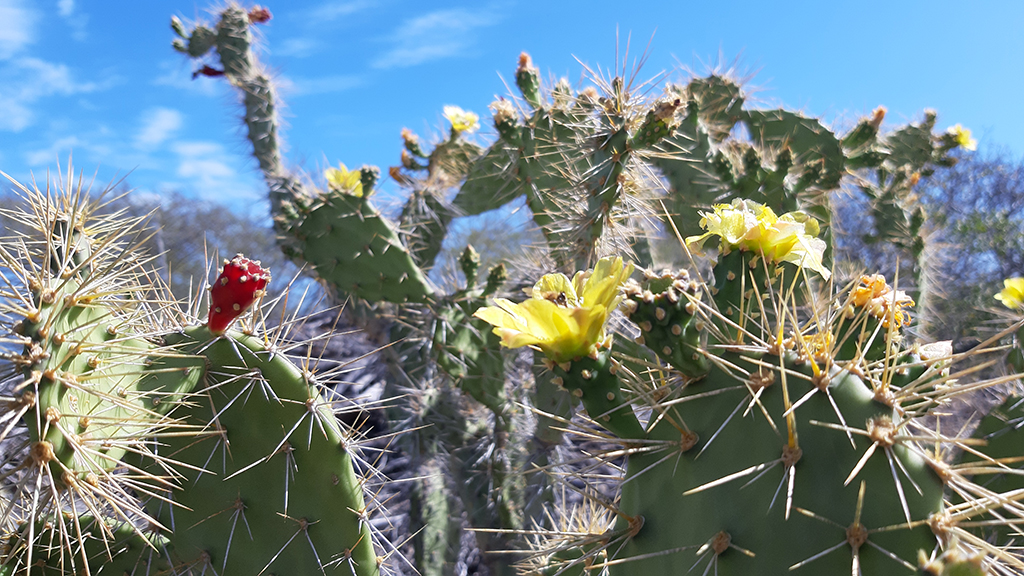A little attention for one of the most hated prickly plants of our island, the Infrou or Opuntia caracassana, a plant that can be used perfectly to keep annoying fellow human beings at bay who do not adhere to social distancing. In nature itself, the spines on the Infrou are also intended to minimize social contact, namely social contact with a predator, or an animal that likes to take a bite of a juicy cactus disc. It is even the case that Infrou cacti that are nevertheless eaten, demonstrably produce more spines on the new discs that grow at the place of feeding. It does not always help, because especially in times of need, cottontails (konènchi), troepials and even deer will brave the prickliest discs to reach the moist inner part.
Also in livestock farming, especially in earlier times, the infrou leaves were used as cattle feed, whereby the spines were first burned off before the nutritious part was given to the animals. Few people know that the Infrou is also perfectly edible for humans. Provided that the spines are burned off, of course. Various types of leaf cacti are a staple food for many in various Latin American cultures and are also widely cultivated. And not only the almost spineless cacti are used for this. The cactus fruits of the Infrou are also edible, provided that the large number of minuscule hairs are carefully removed and therefore do not end up in your airways, mouth, or lips.
On YouTube you can see various videos of the preparation of these plants as food, from cleaning to recipes for the most delicious dishes. Check it out, and who knows what creative ideas we can come up with.
English name: Common prickly pear
Papiamentu name: Infrou
Scientific name: Opuntia caracassana
Family: Cactaceae (cacti)
Occurrence (ABC islands): Aruba, Bonaire and Curaçao

De Infrou

Een beetje aandacht voor een van de meest gehate prikkelige planten van ons eiland, de infrou of Spaanse juffer, een plant die prima ingezet kan worden om, zich niet aan social distancing houdende, irritante medemensen van je af te houden. Ook in de natuur zelf zijn de stekels op de Infrou enerzijds bedoeld om sociaal contact te minimaliseren en wel het sociale contact met een predator, oftewel een dier dat wel een hapje lust van een sappige cactusschijf. Het is zelfs zo dat infrou cactussen die toch worden aangevreten, aantoonbaar meer stekels produceren op de nieuwe schijven die groeien op de plek van vraat. Het helpt niet altijd, want vooral in tijden van nood zullen cottontails (konènchi), troepialen en zelfs herten de stekeligste schijven trotseren om bij het vochtige binnendeel te komen.
Ook in de veeteelt werden, vooral in vroegere tijden, de infrou schuiven gebruikt als veevoer waarbij de stekels er eerst werden afgebrand voor het voedzame deel aan de dieren werd gegeven. Weinigen weten echter dat de infrou ook prima eetbaar is voor de mens. Mits die stekels er natuurlijk af worden gebrand. Verschillende soorten schijfcactussen zijn in verschillende Latijns Amerikaanse culturen een basisvoedsel voor velen en worden ook breed gekweekt. En dat zijn niet alleen de bijna stekelloze cactussen die daarvoor worden ingezet. Ook de cactusvruchten van de infrou zijn eetbaar, mits de grote hoeveelheid minuscule haartjes er zorgvuldig van worden verwijderd en dus niet terecht komen in je luchtwegen, mond, of lippen.
Op Youtube zijn verschillende filmpjes te zien van de bereiding van deze planten als voedsel, van het schoonmaken tot de recepten voor de lekkerste gerechten. Check it out, en wie weet wat voor creatieve ideeën we kunnen verzinnen.
Nederlandse naam: Spaanse Juffer
Papiamentse naam: Infrou
Wetenschappelijke naam: Opuntia caracassana
Familie: Cactaceae (cactussen)
Voorkomen (ABC eilanden): Aruba, Bonaire en Curaçao